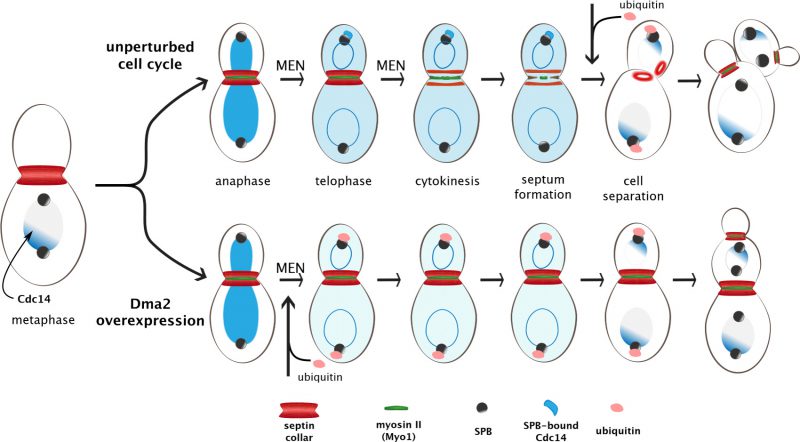Back to article: Septin clearance from the division site triggers cytokinesis in budding yeast
FIGURE 2: Ubiquitylation-mediated control of septin ring splitting and cytokinesis. At the onset of anaphase, the Cdc14 phosphatase (in blue) is released from the nucleolus and diffuses to the nucleus. In telophase, its full release to the cytoplasm prompted by the Mitotic Exit Network (MEN) enables it to reach the spindle pole body (SPB; predominantly the bud-directed SPB) and later on also the bud neck (not depicted). At this stage MEN promotes also septins ring splitting, which in turn allows constriction of the Contractile Actomyosin Ring (CAR) and septum formation. Notice that the myosin II (Myo1) component of the CAR appears at the bud neck in late G1 along with septins, while actin (not depicted) is recruited only in late mitosis in a MEN-independent manner. Once cytokinesis is accomplished, the ubiquitin ligases Dma1/2 ubiquitinate the MEN scaffold Nud1 and shutdown MEN signalling at the SPB. Cdc14 is trapped back in the nucleolus and the two daughter cells start a new cell cycle. Upon Dma2 overexpression (bottom), precocious ubiquitylation of Nud1 hinders Cdc14 recruitment to the SPB, thereby preventing septin ring splitting and CAR constriction. Upon cytokinesis failure daughter cells start nevertheless a new cell cycle, forming new septin rings and new buds, resulting in chained cells with a shared cytoplasm.

